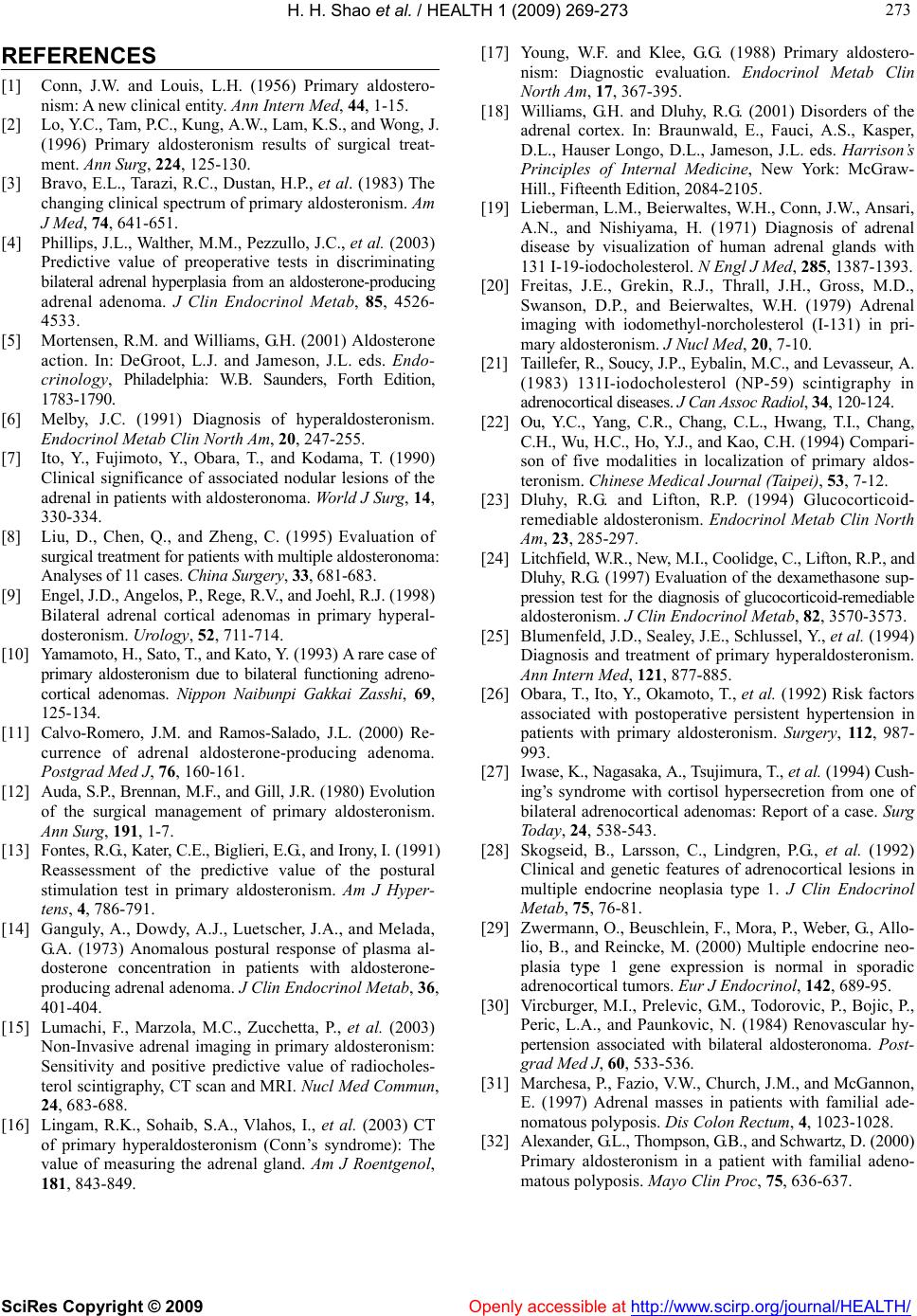
H. H. Shao et al. / HEALTH 1 (2009) 269-273
SciRes Copyright © 2009 http://www.scirp.org/journal/HEALTH/
273
273
[17] Young, W.F. and Klee, G.G. (1988) Primary aldostero-
nism: Diagnostic evaluation. Endocrinol Metab Clin
North Am, 17, 367-395.
REFERENCES
[1] Conn, J.W. and Louis, L.H. (1956) Primary aldostero-
nism: A new clinical entity. Ann Intern Med, 44, 1-15. [18] Williams, G.H. and Dluhy, R.G. (2001) Disorders of the
adrenal cortex. In: Braunwald, E., Fauci, A.S., Kasper,
D.L., Hauser Longo, D.L., Jameson, J.L. eds. Harrison’s
Principles of Internal Medicine, New York: McGraw-
Hill., Fifteenth Edition, 2084-2105.
[2] Lo, Y.C., Tam, P.C., Kung, A.W., Lam, K.S., and Wong, J.
(1996) Primary aldosteronism results of surgical treat-
ment. Ann Surg, 224, 125-130.
[3] Bravo, E.L., Tarazi, R.C., Dustan, H.P., et al. (1983) The
changing clinical spectrum of primary aldosteronism. Am
J Med, 74, 641-651. [19] Lieberman, L.M., Beierwaltes, W.H., Conn, J.W., Ansari,
A.N., and Nishiyama, H. (1971) Diagnosis of adrenal
disease by visualization of human adrenal glands with
131 I-19-iodocholesterol. N Engl J Med, 285, 1387-1393.
[4] Phillips, J.L., Walther, M.M., Pezzullo, J.C., et al. (2003)
Predictive value of preoperative tests in discriminating
bilateral adrenal hyperplasia from an aldosterone-producing
adrenal adenoma. J Clin Endocrinol Metab, 85, 4526-
4533.
[20] Freitas, J.E., Grekin, R.J., Thrall, J.H., Gross, M.D.,
Swanson, D.P., and Beierwaltes, W.H. (1979) Adrenal
imaging with iodomethyl-norcholesterol (I-131) in pri-
mary aldosteronism. J Nucl Med, 20, 7-10.
[5] Mortensen, R.M. and Williams, G.H. (2001) Aldosterone
action. In: DeGroot, L.J. and Jameson, J.L. eds. Endo-
crinology, Philadelphia: W.B. Saunders, Forth Edition,
1783-1790.
[21] Taillefer, R., Soucy, J.P., Eybalin, M.C., and Levasseur, A.
(1983) 131I-iodocholesterol (NP-59) scintigraphy in
adrenocor tica l d ise ases . J Can Assoc Radiol, 34, 120-124.
[6] Melby, J.C. (1991) Diagnosis of hyperaldosteronism.
Endocrinol Metab Clin North Am, 20, 247-255. [22] Ou, Y.C., Yang, C.R., Chang, C.L., Hwang, T.I., Chang,
C.H., Wu , H . C., Ho, Y.J., and Ka o, C.H. (1994) Compa ri-
son of five modalities in localization of primary aldos-
teronism. Chinese Medical Journal (Taipei), 53, 7-12.
[7] Ito, Y., Fujimoto, Y., Obara, T., and Kodama, T. (1990)
Clinical significance of associated nodular lesions of the
adrenal in patients with aldosteronoma. World J Surg, 14,
330-334. [23] Dluhy, R.G. and Lifton, R.P. (1994) Glucocorticoid-
remediable aldosteronism. Endocrinol Metab Clin North
Am, 23, 285-297.
[8] Liu, D., Chen, Q., and Zheng, C. (1995) Evaluation of
surgical treatment for patients with multiple aldosteronoma:
Analyses of 1 1 cases. Ch ina Surgery, 33, 681-683. [24] Litchfield, W.R., New, M.I., Coolidge, C., Lifton, R.P., and
Dluhy, R.G. (1997) Evaluation of the dexamethasone s up-
pression test for the diagnosis of glucocorticoid-remediable
aldosteronism. J Clin Endocrinol Me ta b , 82, 3570-3573.
[9] Engel, J.D., Angelos, P., Rege, R.V., and Joehl, R.J. (1998)
Bilateral adrenal cortical adenomas in primary hyperal-
dosteronism. Urology, 52, 711-714. [25] Blumenfeld, J.D., Sealey, J.E., Schlussel, Y., et al. (1994)
Diagnosis and treatment of primary hyperaldosteronism.
Ann Intern Med, 121, 877-885.
[10] Yamamoto, H., Sato, T., and Kato, Y. (1993) A rare case of
primary aldosteronism due to bilateral functioning adreno-
cortical adenomas. Nippon Naibunpi Gakkai Zasshi, 69,
125-134. [26] Obara, T., Ito, Y., Okamoto, T., et al. (1992) Risk factors
associated with postoperative persistent hypertension in
patients with primary aldosteronism. Surgery, 11 2, 987-
993.
[11] Calvo-Romero, J.M. and Ramos-Salado, J.L. (2000) Re-
currence of adrenal aldosterone-producing adenoma.
Postgrad Med J, 76, 160-161. [27] Iwase, K., Nagasaka, A., Tsujimura, T., et al. (1994) Cush-
ing’s syndrome with cortisol hypersecretion from one of
bilateral adrenocortical adenomas: Report of a case. Surg
Today, 24, 538-543.
[12] Auda, S.P., Brennan, M.F., and Gill, J.R. (1980) Evolution
of the surgical management of primary aldosteronism.
Ann Surg, 191, 1-7. [28] Skogseid, B., Larsson, C., Lindgren, P.G., et al. (1992)
Clinical and genetic features of adrenocortical lesions in
multiple endocrine neoplasia type 1. J Clin Endocrinol
Metab, 75, 76-81.
[13] Fontes, R.G., Kater, C.E., Biglieri, E.G., and Irony, I. (1991)
Reassessment of the predictive value of the postural
stimulation test in primary aldosteronism. Am J Hyper-
tens, 4, 786-791. [29] Zwermann, O., Beuschlein , F., Mora, P., Weber, G., Allo-
lio, B., and Reincke, M. (2000) Multiple endocrine neo-
plasia type 1 gene expression is normal in sporadic
adrenocortical tumors. Eur J Endocrinol, 142, 689-95.
[14] Ganguly, A., Dowdy, A.J., Luetscher, J.A., and Melada,
G.A. (1973) Anomalous postural response of plasma al-
dosterone concentration in patients with aldosterone-
producing adrenal adenoma. J Clin Endocrinol Metab, 36,
401-404. [30] Vircburger, M.I., Prelevic, G.M., Todorovic, P., Bojic, P.,
Peric, L.A., and Paunkovic, N. (1984) Renovascular hy-
pertension associated with bilateral aldosteronoma. Post-
grad Med J, 60, 533-536.
[15] Lumachi, F., Marzola, M.C., Zucchetta, P., et al. (2003)
Non-Invasive adrenal imaging in primary aldosteronism:
Sensitivity and positive predictive value of radiocholes-
terol scintigraphy, CT scan and MRI. Nucl Med Commun,
24, 683-688. [31] Marchesa, P., Fazio, V.W., Church, J.M., and McGannon,
E. (1997) Adrenal masses in patients with familial ade-
nomatous polyposis. Dis Colon Rectum, 4, 1023-1028.
[16] Lingam, R.K., Sohaib, S.A., Vlahos, I., et al. (2003) CT
of primary hyperaldosteronism (Conn’s syndrome): The
value of measuring the adrenal gland. Am J Roentgenol,
181, 843-849.
[32] Alexander, G.L., Thompson, G.B., and Schwartz, D. (2000)
Primary aldosteronism in a patient with familial adeno-
matous polyposis. Mayo Clin Proc, 75, 636-637.
Openly accessible at